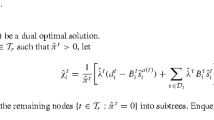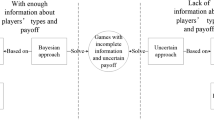Abstract
Uncertain game considers situations in which payoffs are characterized by uncertain variables. This paper goes further by taking into account players’ behaviors. For uncertain game with normal form, we define a new spectrum of uncertain behavioral game. Then, with the frame work of behavioral game theory and uncertainty theory, the expected Nash equilibrium is proposed. A necessary condition is provided in order to find the expected Nash equilibrium. Finally, an example is provided for illustrating purpose.
Similar content being viewed by others
References
Blau A (1974) Random-payoff two-person zero-sum games. Oper Res 22(6):1243–1251
Cachon G, Lariviere M (1999) Capacity choice and allocation: strategic behavior and supply chain performance. Manag Sci 45(8):1091–1108
Camerer C (2003) Behavioral game theory: experiment in strategic interaction. Princeton University Press, Princeton
Charnes A, Kirby M, Raike W (1968) Zero-zero chance-constrained games. Theory Probab Appl 13(4):628–646
Cheng J, Leung J, Lisser A (2016) Random-payoff two-person zero-sum game with joint chance constraints. Eur J Oper Res 252(1):213–219
Gao J (2013) Uncertain bimatrix game with applications. Fuzzy Optim Decis Mak 12(1):65–78
Gao J, Yang X, Liu D (2017) Uncertain Shapley value of coalitional game with application to supply chain alliance. Appl Soft Comput 56:551–556
Gilligan M, Pasquale B, Samii C (2011) Civil War and social capital: behavioral-game evidence from Nepal. SSRN Electron J. https://doi.org/10.2139/ssrn.1911969
Gino F, Pisano G (2008) Toward a theory of behavioral operations. Manuf Serv Oper Manag 10(4):676–691
Harsanyi J (1997) Games with incomplete information played by ’Bayesian’ player. Manag Sci 14(3):159–182
Liu B (2007) Uncertainty theory, 2nd edn. Springer, Berlin
Liu B (2009) Some research problems in uncertainty theory. J Uncertain Syst 3(1):3–10
Liu B (2010) Uncertainty theory: a branch of mathematics for modeling human uncertainty. Springer, Berlin
Liu B (2012) Why is there a need for uncertainty theory? J Uncertain Syst 6(1):3–10
Liu Y, Liu G (2018) Stable set of uncertain coalitional game with application to electricity suppliers problem. Soft Comput 22(17):5719–5724
Nash J (1950) Equilibrium points in N-person games. Proc Natl Acad Sci 36(1):48–49
Neumann V, Morgenstern J (1944) The theory of games in economic behavior. Wiley, New York
Selten R (1965) Spileltheoretische behandlung eines oligopolmodells mitnachfragetragheit. Zeitschrift furdie gesamte Staatswissenschaft 121:667689
Shapley L (1952) A value for N-person games. Ann Math Stud 28(7):307–317
Timmer J (2006) The compromise value for cooperative games with random payoffs. Math Methods Oper Res 64(1):95–106
Wang Y, Luo S, Gao J (2017) Uncertain extensive game with application to resource allocation of national security. J Ambient Intell Hum Comput 8:797–808
Yang X, Gao J (2013) Uncertain differential games with application to capitalism. J Uncertain Anal Appl 1:17. https://doi.org/10.1186/2195-5468-1-17
Yang X, Gao J (2014) Uncertain core for coalitional game with uncertain payoffs. J Uncertain Syst 8(1):13–21
Yang X, Gao J (2016) Linear-quadratic uncertain differential game with application to resource extraction problem. IEEE Trans Fuzzy Syst 24(4):819–826
Yang X, Gao J (2017) Bayesian equilibria for uncertain bimatrix game with asymmetric information. J Intell Manuf 28(3):515–525
Acknowledgements
This work was supported in part by the Major Projects of Chongqing Social Science Planning (ID2018ZD05), the Study on Ecological Civilization Construction and High Quality Development Strategy of the Three Gorges Reservior Area: Chongqing Immigration Bureau, and the Fundamental Research Funds for the Central Universities under Grants 2017CDJSK02XK24, 2017CDJKY and 2015CD-JSK02JD06.
Author information
Authors and Affiliations
Corresponding author
Ethics declarations
Conflict of interest
The authors declare that there is no conflict of interest regarding the publication of this paper.
Ethical approval
This article does not contain any studies with human participants performed by any of the authors.
Additional information
Communicated by Y. Ni.
Publisher's Note
Springer Nature remains neutral with regard to jurisdictional claims in published maps and institutional affiliations.
Appendix A
Appendix A
1.1 Uncertainty theory
Uncertain theory, founded by Liu (2007) and refined by Liu (2010), is a branch of axiomatic mathematics for modeling human uncertainty. Let \(\varGamma \) be a non-empty set, \({\mathcal {L}}\) a \(\sigma \)-algebra over \(\varGamma \), and each element \(\varLambda \) in \({\mathcal {L}}\) is called an event. Uncertain measure is defined as a function from \({\mathcal {L}}\) to [0,1]. In detail, Liu (2007) gave the concept of uncertain measure as follows.
Definition A.1
(Liu 2007) The set function \({\mathcal {M}}\) is called an uncertain measure if it satisfies
Axiom 1. \({\mathcal {M}}\{\varGamma \}=1\) for the universal set \(\varGamma \);
Axiom 2. \({\mathcal {M}}\{\varLambda \}+{\mathcal {M}}\{\varLambda ^c\}=1 \) for any event \(\varLambda \);
Axiom 3. For any countable sequence of events \(\varLambda _1,\varLambda _2, \)\(\ldots , \) we have
Besides, in order to provide the operational law, Liu (2009) defined the product uncertain measure on the product \(\sigma \)-algebra \({\mathcal {L}}\) as follows.
Axiom 4. Let \((\varGamma _k,{\mathcal {L}}_k,{\mathcal {M}}_k)\) be uncertainty spaces for \(k=1,2,\ldots \). The product uncertain measure \({\mathcal {M}}\) is an uncertain measure satisfying:
where \(\varLambda _k\) are arbitrarily chosen events from \({\mathcal {L}}_k\) for \(k=1,2 \ldots \), respectively. Based on the concept of uncertain measure, we can define an uncertain variable.
Definition A.2
(Liu 2007) An uncertain variable is a function \(\xi \) from an uncertainty space \((\varGamma ,{\mathcal {L}},{\mathcal {M}})\) to the set of real numbers such that \(\{\xi \in B\}\) is an event for any Borel set B of real numbers.
Definition A.3
(Liu 2007) The uncertainty distribution \(\varPhi \) of an uncertain variable \(\xi \) is defined by
for any real number x.
Example A.1
An uncertain variable \(\xi \) is called normal if it has a normal uncertainty distribution
denoted by \({\mathcal {N}}(e,\sigma )\) where e and \(\sigma \) are real numbers with \(\sigma >0\).
Definition A.4
(Liu 2010) An uncertainty distribution \(\varPhi (x) \) is said to be regular if it is a continuous strictly increasing function with respect to x at which \(0<\varPhi (x)<1\), and
Definition A.5
(Liu 2010) Let \(\xi \) be an uncertain variable with regular uncertainty distribution \(\varPhi (x)\). Then the inverse function \(\varPhi ^{-1}(\alpha )\) is called the inverse uncertainty distribution of \(\xi \).
Example A.2
The inverse uncertainty distribution of normal uncertain variable \({\mathcal {N}}(e,\sigma )\) is
Definition A.6
(Liu 2009) The uncertain variable \(\xi _1, \xi _2, \ldots , \xi _n\) are said to be independent if
for any Borel sets \(B_1, B_2, \ldots , B_n\) of real numbers.
Definition A.7
(Liu 2007) Let \(\xi \) be an uncertain variable. The expected value of \(\xi \) is defined by
provided that at least one of the above two integrals is finite.
Based on the definition of inverse uncertainty distribution, we can get the theorem below, which is convenient to calculate the expected value of uncertain variable.
Theorem A.1
(Liu 2007) Let \(\xi \) be an uncertain variable with regular uncertainty distribution \(\varPhi \). If the expected value exists, then
Rights and permissions
About this article
Cite this article
Zhao, H., Li, J. & Jiang, X. Static uncertain behavioral game with application to investment problem. Soft Comput 24, 2479–2485 (2020). https://doi.org/10.1007/s00500-018-03737-y
Published:
Issue Date:
DOI: https://doi.org/10.1007/s00500-018-03737-y




